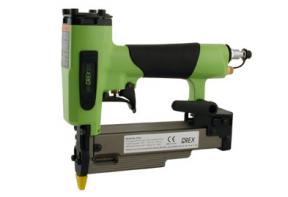The pros of pin nailers
Find out why these quiet, easy-to-use tools are an asset to your workshop
Imagine being able to fasten trim, moulding and small pieces of wood instantly and invisibly with a flick of your index finger. No more obvious nail holes; no more filling. Pin nailers promise this, and while they’re not a replacement for finishing nailers, they do have a lot to offer. Also called pinners, headless pinners or micro-pinners, these specialized pneumatic fastening guns deliver substantial benefits that few home workshoppers have experienced yet. They’re also quiet and pleasant to use.
How do they work?
All pin nailers shoot the same kind of ultrathin metal fasteners. Headless 23-gauge pins come in various sizes from 3?8″ to as long as 2″; however, not every model can handle all lengths. A 23-gauge pin is about the same thickness as a sewing needle, and it’s this small diameter that makes pin nailers so helpful. Most pin nailers can penetrate the hardest hardwoods with ease. Even though the pins have no heads, they provide surprising holding power. For maximum durability, add a little glue to your pinned joints, using the pins to replace clamps in many situations.
The pinner shines when it’s used in the installation of small and medium-size moulding on cabinets, furniture and interior millwork. Because moulding often has an irregular shape, it is difficult to hold with clamps as glue dries. Using nails to hold trim is also problematic because the nail holes look ugly, even after filling. A few pins from a 23-gauge nailer, however, can hold pieces together without a trace.
Light pieces of wood are not the only things that are well suited to the pin nailer. Gluing and clamping larger pieces of wood together precisely can often turn into a slippery wrestling match as even carefully applied clamping pressure causes the components to slide. A couple of shots with a pin nailer, however, solves this problem. The pins prevent any side-to-side movement of glue-covered wooden parts.
Pin nailers are finesse tools, and a big part of their success comes from their ability to deliver pins exactly where they’re needed. The business end of a pin nailer is typically much different than what you find on every other kind of pneumatic fastening tool. Other nailers have a retractable nose-piece that must be pressed down against the workpiece before the gun will fire, but pinners typically do not. Most manufacturers deem this arrangement too bulky to allow for full visibility of the gun tip. Instead, most pin nailers use a dual trigger arrangement to prevent accidental misfiring. You need to depress one trigger to engage the tool, then a second trigger when you actually want to fire. The design of this safety-interlock system has a lot to do with how a particular pinner performs.
Although a pin nailer probably isn’t the first pneumatic fastening tool you should buy for your workshop, it could be the second. Speed of project assembly and more refined furniture, cabinets and trimwork are the reasons why. Pin nailers may be new tools, but they’re definitely here to stay.
To leave a comment, please log in












No comments